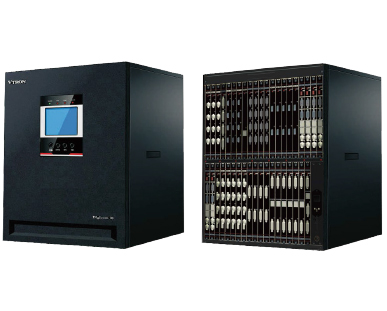Digicom® HC5000 series
VTRON’s Digicom® HC5000 is a hardware-based video wall processor series integrated with RIET technology to achieve stable and high-performance image processing. In additional, separated video walls can be driven by one set of Digicom® HC50001 simultaneously. Digicom® HC5000 is ideal to fulfil the demanding 24/7 visualisation needs in control and command centres, data centres and operations monitoring centres.

Embedded with RIET technology
Embedded with the Real-time Intelligent Exchange Transmission (RIET) technology, each signal is allocated to a dedicated high-speed data channel to achieve real-time transmission.
Powerful processing performance
Single chassis of Digicom HC5000 can drive up to 64 display units.
Handles multiple resolutions from multiple sources including DVI, VGA, video, HDMI, DP, SDI simultaneously in real-time.
Various combinations of input sources can be resized, overlapped and placed anywhere on the video wall.
- Multiple types of video walls or different configurations of video walls can be driven by one set of Digicom® HC5000 simultaneously, which greatly saves system cost and makes the system simple.
Super high-resolution background
Digicom® HC5000 supports to run a large static background in super high-resolution across the entire video wall that the saved graphics such as map and modelled building image can be recalled from the built-in Web control interface.
Flexible modular design for easy maintenance and expansion
Digicom® HC5000 is easy to maintain and expand because of its advanced modular architecture that all signal I/O boards and fans are hot swappable. The signal I/O boards are supported with instant image recovery after the modules are hot swapped. This feature allows the new modules to be replaced without disassembling the processor case or rebooting the video wall processor. Also, system expansion can be carried out by inserting additional signal I/O boards while the processor is running.
VTRON's Software
VTRON Video Wall Management System (VWAS/VCMS/VEMS) provides:
Window operation management
- Open/close/resize/move the signal windows
- Window properties
System information management
- Log management
- Operating information
- Warning information
Hardware device management
- VTRON video wall and processor management
- Matrix switch management
- Multi-function device management
- Digital signal server management
- Signal source management
Layout management
- Create/save/delete display layout
- Launch display layout
- Scheduling of layouts
Allowed third party device controls
- Launch display layout
- On/off VTRON video wall
VLinkExpress, a high performance screen captured software:
- It allows multiple Windows® based desktops on client PCs to be captured via LAN and displayed on the display wall.
- The proprietary screen captured algorithm provides high speed and high performance capturing of desktop images. Its performance is several times higher than other 3rd party screen capture software.
- The screen captured by VLinkExpress can be resized, moved or opened/closed on the VWAS.
- The content of captured screen can be accessed by using mouse and keyboard.
Specifications
Number of inputs Up to 72 channels of 1080P HDMI / DVI / VGA / SDl; or Up to 36 channels of DP / 4K HDMI; or Up to 144 channels of 1080P IP video; or Up to 288 channels of CVBS
VGA input board (optional) 4 channels per board Up to1920x 1200@ 60Hz Signal input connector: VGA
DVI input board (optional) 4 channels per board Up to1920x 1200@ 60Hz Signal input connector: DVI
DVI input board (optional) 4 channels per board Up to 1920 x 1200@ 60Hz Signal input connector: DVI
HDMI input board (optional) 4 channels per board Up to 1920x 1080@ 60Hz Support HDMI 1.3, HDCP 1.4 Signal input connector: HDMI
HDMI (4K) input board (optional) 2 channels per board Up to 3840x 2160@ 30Hz Support HDMI 1.4, HDCP 1.4 Signal input connector: HDMI
DP input board (optional) 2 channels per board Up to 3840x 2400@ 30Hz Signal input connector: DP
SDI input board (optional) 4 channels per board Support SD/ HD/ 3G SDI Signal input connector: BNC
Video input board (optional) 4 channels per board CVBS input format: NTSC, PAL Signal input connector: BNC 16 channels per board CVBS input format: NTSC, PAL Signal input connector: BNC
IP decoding board1 (optional) Up to 8 channels of 1920 x 1080@ 30Hz per board Support resolution: 1080P, 720P, D1 Support standard H.264 and standard RTSP Signal input connector: RJ45
Number of DVI output (optional) Up to 64 x DVI-D Up to 1920 x 1080@ 60Hz
Signal preview (optional) Preview: DVI + IP Output resolution: 1920 x 1080@ 60Hz (DVI), 1920 x 1080@ 30Hz (IP) Output connector: DVI-D, RJ45
Live view (optional) Live view: DVI + IP Output resolution: 1920 x 1080@ 60Hz (DVI), 1920 x 1080@ 30Hz (IP) Output connector: DVI-D, RJ45
IP streaming board3 (optional) 4 channels of 1920 x 1080 @ 30Hz per board Video coding: H.264, Protocol: RTSP Output connector: RJ45
Multiple resolution DVI output board3 (optional) 4 channels per board Output resolution: 1024 x 768 / 1400 x 1050 / 1366 x 768 / 1920 x 1080 Sharing video wall signals on extended displays (e.g. cubes, LCD panels or monitors). And its output resolution is configured to match the native resolution of each display. Output connector: DVI-D
Hot swappable module with instant image recovery Signal board
System control Dual RJ45 ports, 10/ 100Mbps self-adaptive Support configuration of network application, such as IP address, gateway, time server, etc
Intelligent management Support alarm monitoring for temperature, fan, power supply, etc Support version review and online software upgrade
Cooling fan Redundant hot swappable fan
Power supply N + 1 hot redundant power supply AC 100V – 240V, 50/ 60Hz, 10 – SA
Power consumption ≤800W
Operating environment Temperature: 0°C – 40°C Relative humidity: 10% – 90% (non-condensing)
Dimensions (W×H×D) 439.4 mm × 577.6 mm × 589 mm 19″ chassis, 9 U high
Qualifications CCC, CE, CB, RoHS
VTRON’s software VWAS (mandatory), VIS (optional)
Remarks: Specifications are subject to change without prior notice.
1. This feature depends on actual hardware configuration and application which need prior verification
2. Compatibility needs prior verification
3. These boards occupy the output slots
4. Depends on the type of display unit and actual application
